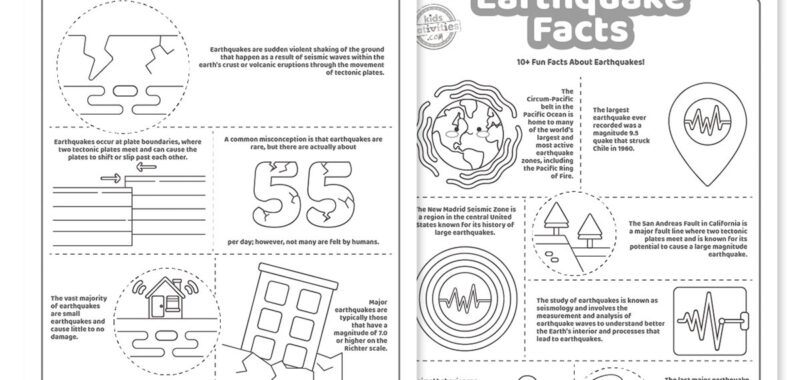Do you have a budding scientist that is fascinated by earthquake facts? Do they read anything associated with the United States Geological Survey about seismic activity or natural disasters on the earth’s surface? If they love anything related to earthquakes use these earthquake facts coloring pages at home or in the classroom.
FREE PRINTABLE earthquake facts COLORING PAGES
There is a possibility of an earthquake happening in all parts of the world, luckily, we don’t always feel them!
But if you find yourself in one, it’s important to know the safest places in your home are under a sturdy piece of furniture or a sturdy table along an interior wall. It’s also a good idea to have an emergency kit and have emergency services numbers available if earthquake damage occurs.
Now, back to interesting earthquake facts! Did you know the west coast, near the Pacific Coast, has the most significant earthquakes in the world? About 81 percent of our planet’s big earthquakes occur here!
Download here–>
Earthquake Facts Coloring Pages
Earthquake Facts FOR KIDS
- Earthquakes are sudden violent shaking of the ground that happen as a result of seismic waves within the earth’s crust or volcanic eruptions through the movement of tectonic plates.
- Earthquakes occur at plate boundaries, where two tectonic plates meet and can cause the plates to shift or slip past each other.
- A common misconception is that earthquakes are rare, but there are actually about 55 per day; however, not many are felt by humans.
- The vast majority of earthquakes are small earthquakes and cause little to no damage.
- Major earthquakes are typically those that have a magnitude of 7.0 or higher on the Richter scale.
- The Circum-Pacific belt in the Pacific Ocean is home to many of the world’s largest and most active earthquake zones, including the Pacific Ring of Fire.
- The largest earthquake ever recorded was a magnitude 9.5 quake that struck Chile in 1960.
- The New Madrid Seismic Zone is a region in the central United States known for its history of large earthquakes.
- The San Andreas Fault in California is a major fault line where two tectonic plates meet and is known for its potential to cause a large magnitude earthquake.
- The study of earthquakes is known as seismology and involves the measurement and analysis of earthquake waves to understand better the Earth’s interior and processes that lead to earthquakes.
- Animal behavior can be a warning sign for earthquakes, as some animals may exhibit unusual behavior or flee the area before an earthquake occurs.
- The last major earthquake to occur in the Cascadia Subduction Zone was in January 1700 and is believed to have had a magnitude of 9 or higher. It produced a tsunami that could reach a height of 80 to 100 feet.
This article contains affiliate links.
DOWNLOAD FREE earthquake facts COLORING PAGES PDF FILES
This coloring page is sized for standard letter printer paper dimensions – 8.5 x 11 inches.
Earthquake Facts Coloring Pages
This pdf file includes two coloring sheets loaded with Earthquake Facts that you don’t want to miss. Print as many sets as needed and give them to friends or family!
RECOMMENDED SUPPLIES FOR earthquake facts COLORING SHEETS
MORE FUN FACTS COLORING PAGES FROM KIDS ACTIVITIES BLOG
What was your favorite earthquake fact?

